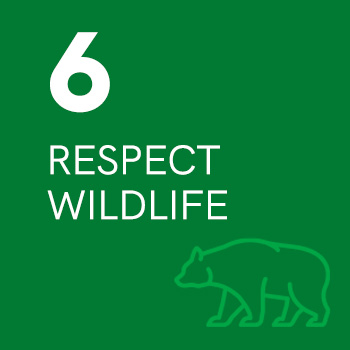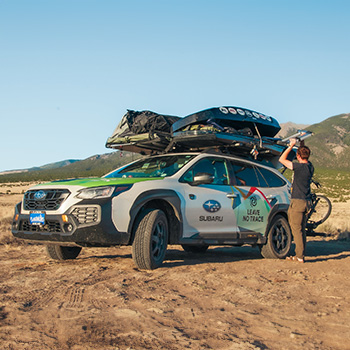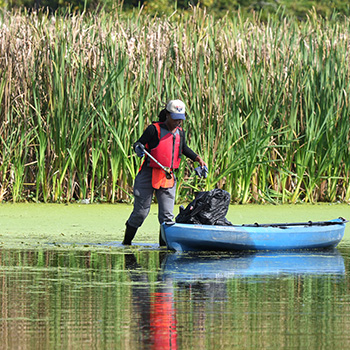Most nights of the year, Becca and Luke McGraw sleep in a tent perched on top of their Subaru Outback Wilderness, typically parked at a campsite in a beautiful natural setting. But sometimes, depending on where work takes them, they might sleep on top of their vehicle parked in the lot of a Cabela’s® outdoor supply store or take advantage of an Airbnb to do some laundry.
The married couple make up one of three Leave No Trace Traveling Teams, which road trip across the United States teaching outdoor enthusiasts the best ways to enjoy trails and trees while also preserving the resources for others to enjoy. Their reach stretches coast to coast and anywhere from urban parks to the nation’s vast wilderness areas.

Former teachers, the McGraws love being outside and applied for the job on a whim during the pandemic. Now, they reach the growing and diverse numbers of hikers, campers, dog walkers and others who cultivated a love for the outdoors during the pandemic and continue to enjoy it.
They also delight in showing others how a person with a disability can both lead and enjoy the outdoors. Luke McGraw says he has about 30% vision, and Becca does all the driving.
Public lands are “getting much more engagement from people who have not traditionally spent time outdoors – especially people of color, people with disabilities, all sorts of people who have not traditionally spent time outside. We’re seeing a lot more engagement and a lot more participation,” Luke says.
How It All Got Started
Based in Boulder, Colorado, Leave No Trace began unofficially in 1987 with a pamphlet to instruct those traveling in federally owned wilderness and backcountry about how to do so with minimum impacts on the land. The program grew in the early 1990s when the National Outdoor Leadership School was asked to develop training for nonmotorized recreation. In 1993, Leave No Trace formed as an independent organization, incorporating in 1994.
Five years later, Subaru became a Leave No Trace partner, working together with the organization to create the Traveling Trainer Program. Since then, Leave No Trace trainers have reached more than 220 million people in 49 states nationwide.








Leave No Trace Training
In addition to the education offered by Traveling Teams, Leave No Trace offers free online education. The introductory LNT 101 Course provides 47 lessons, and their Backcountry Course consists of 39 lessons, including a 101 Course Recap. There are also in-person courses for instructor training and a Youth Program Accreditation.
As for the McGraws, “They’ve completed the newest, latest and greatest Leave No Trace training,” says Faith Overall, community engagement manager for Leave No Trace. The couple is currently driving across the U.S. leading events from a Girl Scout program to a “communication workshop with land managers to teach them how to talk to visitors.”



What Do Traveling Teams Do?
Traveling Trainer Teams road trip across the country in their Subaru vehicles providing hands-on educational training, workshops and outreach programs for children and adults.
The teams visit big festivals, Subaru WinterFest events and camp more than 250 nights of the year, Overall says. A local Colorado artist designed the wrap that encompasses and decorates the vehicles that each team occupies for about nine months.
Their outreach is important, Overall says, as community leaders and land managers ask Leave No Trace to help them reach the influx of new visitors who got active outside for the first time during or after the pandemic.
“The majority of folks don’t want to create impacts outdoors – they just don’t understand how their behaviors are causing impacts,” Overall says. “Even some folks who are seasoned. I run into people who have been outdoors their whole life, and I have to tell them to pick up their dog poop.”

Some visitors might be taking up a new activity, such as hikers who start rock climbing, and need to learn best practices for that hobby, e.g., how to scale a rock with minimal impact to the stone. Or maybe they know Leave No Trace practices for a rainy deciduous forest and then visit the Utah desert and need to learn the least invasive spots to urinate and pitch a tent, Overall says.
Leave No Trace works with the biggest federal land management agencies in the United States, including the U.S. Forest Service, Bureau of Land Management (BLM), U.S. Fish and Wildlife Service and National Park Service.
In 2007, leaders partnered with the National Association of State Park Directors. Now, efforts stretch far beyond the backcountry to reach those walking on a neighborhood rail trail, to mountain biking in a county park, to running trails on BLM land.
The two-person Traveling Teams host multiday Spotlight events, focusing on community conservation and education in popular outdoor destinations, and lead multiday programs at designated Hot Spots, popular outdoor areas that have been overused but still can be restored.

A Former Advocate Reports Back
Gillian Rossi, parks and recreation director for the city of Manitou Springs, Colorado, says she served as a LNT Colorado state advocate for more than two years. The lessons she learned have helped her in her current job and her previous position with the city of Colorado Springs.
“It’s really important to not come off like you’re shaming people or yelling at them, nothing negative,” Rossi says. “That’s the reason I like to go with the LNT model. It’s all about positivity and giving people the benefit of the doubt. No one is outside to maliciously harm our parks and outdoor spaces. They just don’t have the experience and knowledge of how to take care of them sometimes.”
In both communities she reached out to the local parks friends’ groups for help putting the practices in place. In turn, those groups began doing trail work and cleaning up dog feces and trash. She said she’s still learning new things from Leave No Trace.
“It’s what you don’t see that kind of speaks the loudest,” Rossi says. “You notice when things are out of place or if there’s a complaint or if a park has been destroyed by a large group. When the park looks great, sometimes it just blends into the background.”






